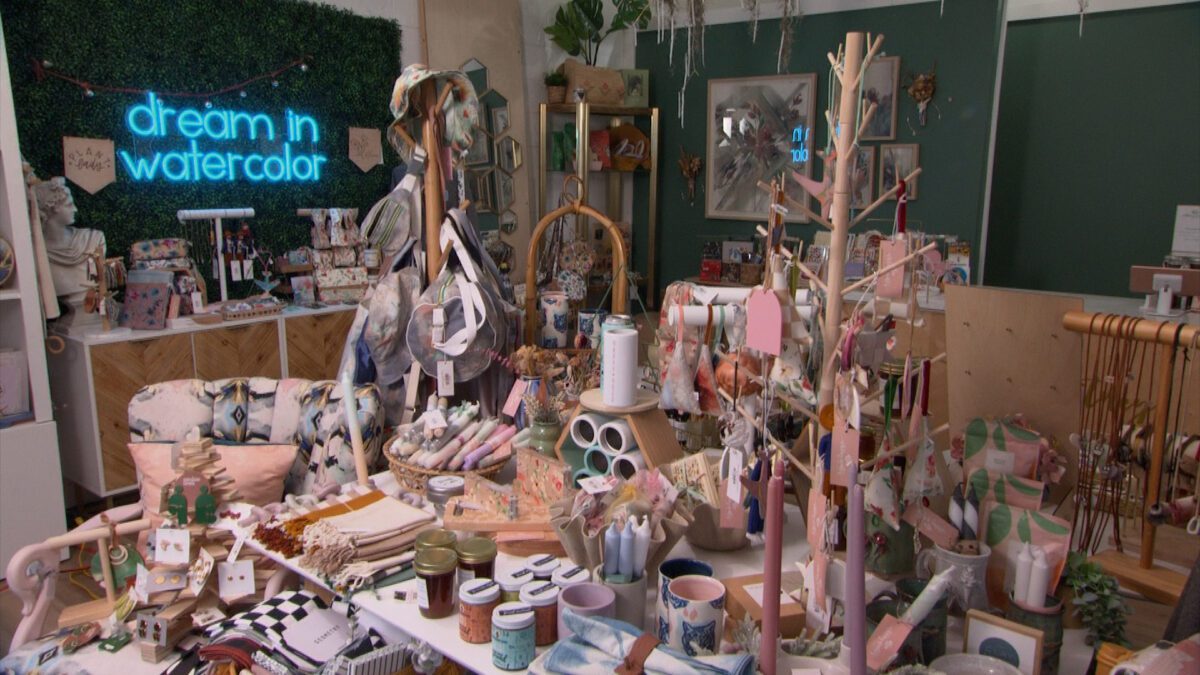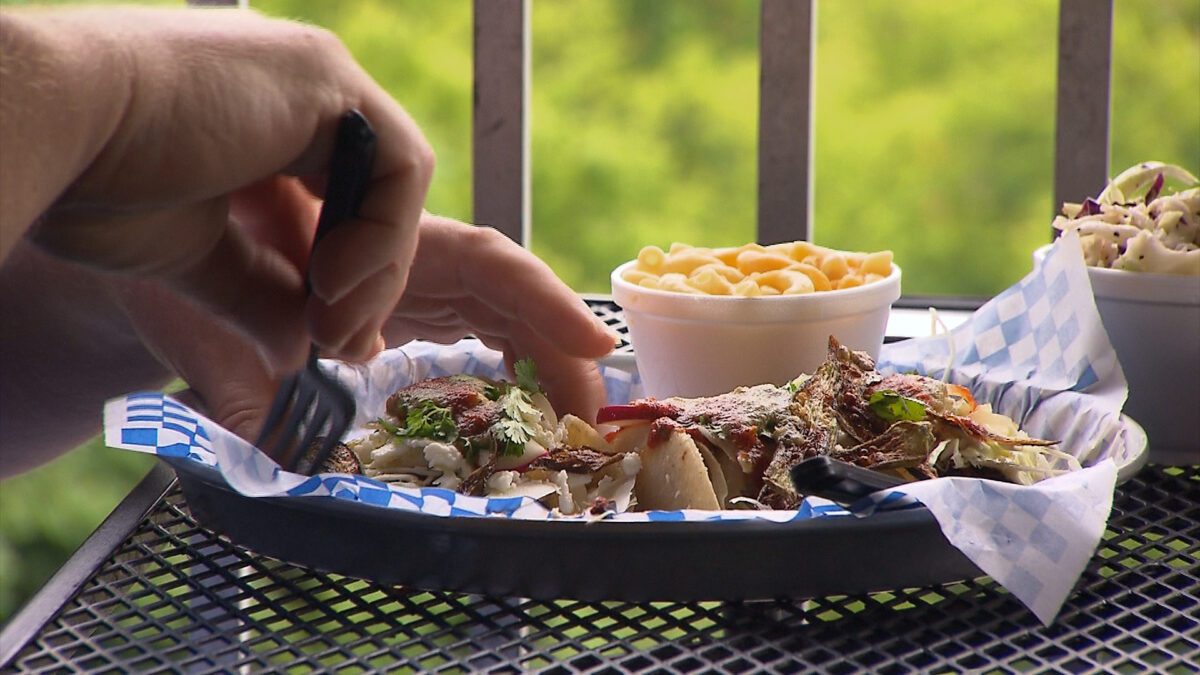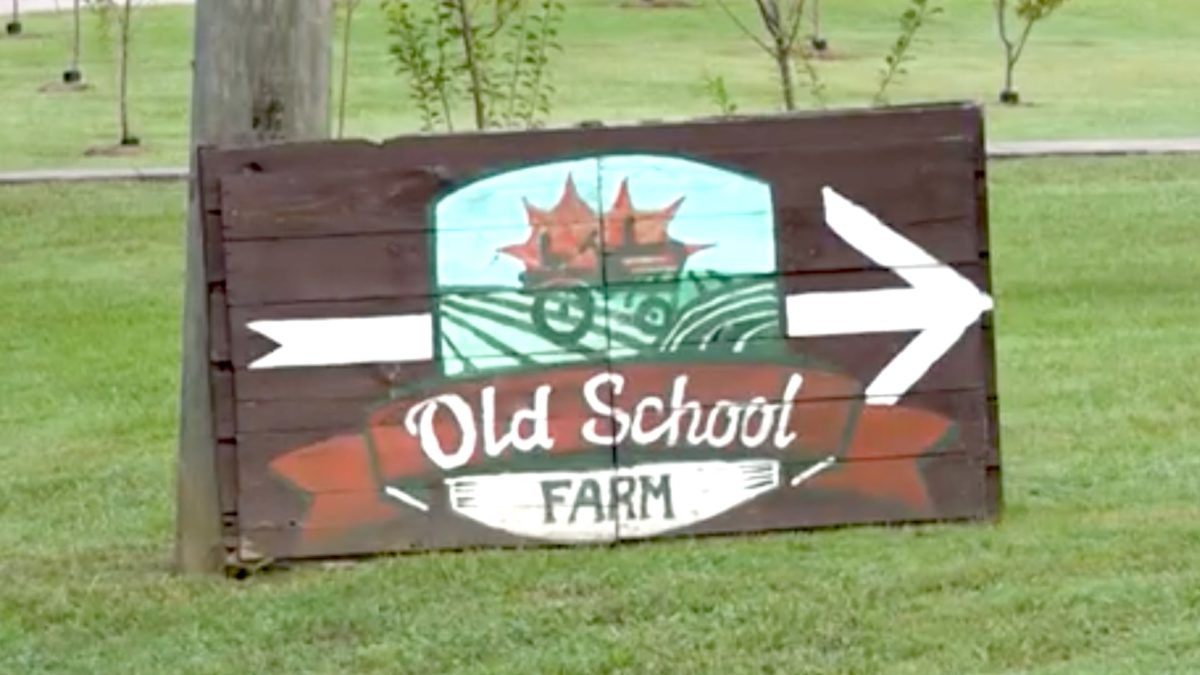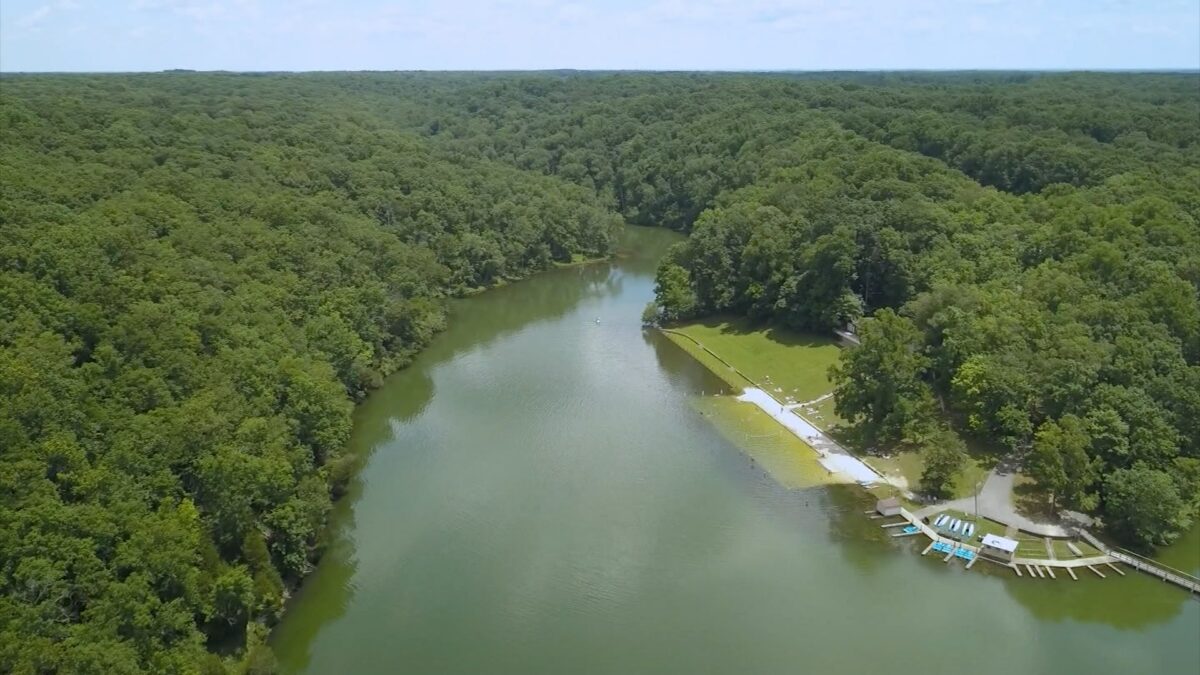Episode 3628
Don't have the PBS App? Click Here
Episode Transcript
- [Narrator] Tennessee Crossroads is made possible in part by- - I'm Tennessee Tech President, Phil Oldham. Here in Cookeville, Tennessee's college town, we are bold, fearless, confident, and kind. Tech prepares students for careers by making everyone's experience personal. We call that, living wings up. Learn more at tntech.edu. - This time on Tennessee Crossroads we discover some great barbecue high on a hill in Chattanooga. Then, meet an accomplished watercolor artist in Memphis. We'll enjoy the beauty and history of Montgomery Bell State Park and finally discover the mission of the Old School Farm near Nashville. Hi folks, I'm Joe Elmore. Welcome again to Tennessee Crossroads. Sure, glad to have you. If you're a regular Crossroads viewer, it's probably no surprise that our first story involves barbecue. If you've driven to Chattanooga you may have seen this restaurant perched high atop a hill. Well, Miranda Cohen decided to climb that hill and she learned it's not only a great place for barbecue ribs, it's also an experience you'll never forget. - [Miranda] Nestled high on Missionary Ridge in Chattanooga, the locals and travelers from all over just seem to know where to go. - Who's next? - [Miranda] Sugar's Ribs is owned by successful restaurateur, Lawton Haygood. And under the watchful eye of chief of operations, Jesse Rogers, they are up in the clouds serving up comfort food. - You're aimed downtown Chattanooga, but you also see Lookout Mountain just over to the side, so you get a little mountain, a little bit of city. And in the evening with the lights, it's lovely sunset, I mean, you can't beat it. - [Miranda] As if you need more to draw you in, they are serving up the classic southern staple barbecue and with a name like Sugar's, you know it's going to be good. - [Jesse] It was just kind of an homage, you know, southern barbecue, sweet. We do St. Louis style ribs. We don't do baby backs. I feel that the fat content on the spare ribs is better. It has a little bit more moisture because of of the fat and a little bit more tender. The old adage of low and slow is still the way to go. So, how low and how slow and all of that comes into play. So, we smoke all our meats in-house, 12 hours is generally what we do. But that's almost in some ways the easy part. It's okay, what can we do to make sure that when it hits the plate in front of you, it is as close to the way it was when we pulled it out of the smoker. That's the trick. - [Miranda] And whatever the trick is, they have it figured out. Along with ribs, Sugar's serves the pulled pork, chicken chopped brisket, barbecued tacos, and even house-made sausage. - [Jesse] He didn't want something that was just full of sauce on the meat. He wanted the meat to stand as the primary and have accent sauces, which is not necessarily what you see everywhere. Some places it's all about the sauce and they just load it up and the meat, you don't even know what you're eating. - [Miranda] And Rogers knew when he took the job, barbecue is a rather sensitive subject here in the South. - You are on the money. Everyone knows if you ask their opinion they know the best way to do barbecue. A hundred percent. And no matter what you do, somebody thinks you're wrong. - [Miranda] And Sugar's came up with a way to solve that problem too. - [Jesse] Our style was, really, we wanted to pay homage to some of the other styles, with some of the sauces from different regions. - [Miranda] Even for diehard barbecue fans, there are plenty of special potions to pour on, drizzle or dip the flavor you crave. Thanks to a huge variety of house-made sauces, like Southern Classic, Carolina Red, Mustard, Clearly Great, Tennessee Sweet & Goopy, and what sweet without sassy, meet their signature sauce, they call Hot Lips. - [Jesse] We decided to take peppers and onions and grill them on the grill. Get some good smoke and a little, you know, color on there and then chop that up, turn it into a sauce. So, you have the smokiness and the pepper flavor, but the heat to give it, you know, give a little tangle around the lips. - [Miranda] Your hot lips cut. Tell me about how spicy is that? - On a scale of one to 10 I'd give it maybe about seven and a half or an eight. It has the habaneros in it, so it's a little bit warm, but it's the right type of warm, it's a slow burn going down. - [Miranda] And just as long and distinguished as the sauce list is the list of southern sides, like Texas pinto beans, corn on the cob, and again, trying to keep the piece, they have two versions of coleslaw, mayonnaise based and vinegar based. - [Jesse] We also do what we call okra chip where we slice the okra very, very fine and fry them up to their, just crispy, put a little seasoning on top and they're kind of like potato chips but okra. - They had a lot of awards, and so, I like good barbecue and their ribs are great. So, I didn't get this body by going to lousy restaurants that's all I got to say so- - [Miranda] And just when you thought it couldn't get any better, Rogers pulled some strings with the best cook he knew to round out the dessert menu. - This one is near and dear to my heart. So, the recipe for the banana pudding that we do is literally my grandmother's recipe. And I don't mean, it's like, somebody says that and it's a story... No, literally my grandmother's recipe, Jesslyn McClure, and so, we call it Jesslyn's Banana Pudding. And so, it's made from scratch, you know, it's not out of a box and made with love since I was a little kid. It brings a smile to my face every single time I get to see somebody have that because it's a little piece of my childhood and it's amazing. - [Miranda] And at Sugar's it's not all about the food and friendly staff, even the lawn mowing crew is the greatest of all time. So, here at Sugar's, you think the barbecue is the real star of the show? Nope. How about the sauce? You think it's the star of the show? It's not either. Okay, the real stars of the show and one of the biggest draws here at Sugar's is the beautiful goats. You get your piece of cabbage and they come running. Everybody eats great here at Sugar's. - [Jesse] We have people that come and love the these goats. Three or four times a week you'll see them out there. So, we love them too, but they have a job, they're here to work, so people take photos and post stuff on Instagram and all the social media and it's great. - That's all the food I have. - [Jesse] We want people to be happy. We want to see those smiles on their face. And you see that with barbecue and more than some places because you don't have to be serious here. I mean, it's barbecue, you got sauce on your face and it's okay 'cause it's barbecue, so you don't have to be fake or think about anything else. You just sit down, smile, be happy, have fun. - Thanks Miranda. For the subject of our next story, the Bluff City's not only her home, but part of the secret to her success as a full-time artist and gallery owner. Laura Faber heads to Memphis to see the beautiful watercolor work of Whitney Winkler. - So we are at Whitney Winkler art studio and shop. It is my retail space where I can share my art with people that walk through the doors and work at the same time. - [Laura] You won't find an easel inside the studio of Memphis artist, Whitney Winkler. - I usually say I'm an artist and I specialize in fine art, prints, textiles, and like, functional art, useful art. - [Laura] Because she uses a lot of water when creating, she works best on flat surfaces. The result is works of art that are fluid and dreamy with gorgeous pallets of color. - [Whitney] So I started in watercolor. Any high flu... Any like fluid paints, so I love watercolor, I love fluid acrylic. It's basically just, it's acrylic that's not thicker, you know what I mean, you know what I'm saying? Ink, all of those are really my faves. I do a lot of mixed media work, so I've started adding some oil pastels and some gold leafing to my stuff. I use graphite. I really have fun with a lot of mediums, but the base of everything I do is like a fluid painting. - [Laura] Whitney started painting when her children were newborns and she needed an escape. While she's always been creative, she is self-taught. - [Whitney] I really don't love to look at a lot of technique either because I feel like it's... It's not really my personality to like read directions. For me, the reason I've been able to branch out in so many ways is I don't have a lot of inhibition or a lot of fear surround... Like, I'm okay to fail and I've throw away a lot of paintings. - [Laura] Whitney branched out into textiles after a suggestion from a customer. - So often the things I create are things that they ask for, art like... Especially, once I started to make the textiles, they were like, do you have this? Like, and I'm like, no, but let's do it. So, listening to them, responding to what they're asking for but still getting to do that with my own creative license. Like, I don't ever feel like I'm sacrificing creativity to do that. When scrunchies came back in, somebody was asking for scrunchies and we were like... But now, I'm like, I can't imagine life without scrunchies. - [Laura] Charlotte Turtle, the graphic designer for the team turns Whitney's artistry into a printable pattern for fabric. - So, I take Whitney's paintings and scan them in high resolution and then I take almost like scissors, cut out each piece of the design and lay it out into a pattern, so that the fabric is repeating, so our seamstresses can make something from them. - The team also includes several seamstresses. They take the textile patterns and create what customers want and original products too. Today, bows are on the agenda with Whitney's pattern. Probably the biggest corporate collaboration that Whitney has had so far has been with international retailer, Anthropologie. They asked her to create a pattern for their travel collection. A clutch, a passport holder, and this luggage tag. They also love her designs of states. They asked her to do a print for the state of Texas, California, and New York, which they eventually put on coffee mugs. Price point is top of mind for Whitney. If it's not affordable, she and her team don't make it. She is known for her beautiful prints of states, cities and stadiums, her textiles, and the flex of gold in everything. - We still add gold by hand to every print. So, every last print that comes out of the studio is embellished with... So it has that hand added touch to it. And so, I think people, like they're getting something at a great price point, but that's something that's still really special. - [Laura] She does commission work, sells online and out of her gallery. A space that also features work from other local artists. - I have a passion for lifting up other small businesses. So, a huge vision of this shop going forward was, it was never just gonna be me. Like I always wanted to grow and include small businesses because I know just as much as the next person in this world, like it is everything to be represented. So, it's just a joy for me to buy these products. I own all of these products. I don't put the risk on them, I put the risk on myself. It's a joy to me to support them and to say, you know, I wanna represent you in whatever small way that I can. - [Laura] Like most working artists who are able to make a living by creating, Whitney is grateful and credits two things for her success. - Absolutely am so grateful. I credit, honestly, I credit Memphis for being like this. I got to talk Memphis up because Memphis is a city that is ready to rally around good things. Like it is a great place to come and live and start a business and people are excited to cheer you on. And I don't know that this would've worked in a different city. Delegating and letting other women run with what they're good at and not putting that all on myself, it's exponential. Like, 'cause it then, it kicks me back to be able to paint and create and be the visionary. And so, those two things, I am so grateful. Memphis and then my team, it's delightful. - Hey, looking for a great place to enjoy some great outdoors? Well, how about a Tennessee State Park? Not too long ago a Crossroads' crew and I went to Montgomery Bell State Park and we found the place full of things to do, whether you explore the beauty of nature, or it's intriguing history. It covers about 4,000 acres of scenic Tennessee beauty. Only a few miles from Dixon, yet once inside you feel like you're worlds away from so-called civilization. Surrounded by natural splendor that beckons to be explored and enjoyed. - We're very blessed we've got a whole lot of different opportunities. Outdoor opportunities, indoor opportunities, and a lot of history too, so it's kind of a good combination of everything. - [Joe] Eric Runkle loves his job. He's a ranger here at Montgomery Bell State Park and considers himself lucky to live and work in this natural playground. - Best part of the variety. I've got a little bit of everything. Some days I'm talking to folks giving them guidance on where different things are in the park. Some days I'm out helping them for whatever reason, could it be injured visitors, could it be lost hikers. You know, the variety of things I get to do in a day is just amazing. - The park was developed in the late 1930s and early 40s using labor from the Civilian Conservation Corps and the Workers' Progress Administration. It officially became a state park in 1942. The park's namesake moved here in the late 1700s to buy an ironworks operation. Eventually, his furnaces were producing everything from farm tools to cannon balls. In fact, those cannon balls helped General Jackson's army beat the British in the war of 1812. Ironically, the main furnace on the grounds wasn't owned by Bell, but remnants of the once bustling iron industry were like this piece of slag can still be found today. Montgomery Bell is home to another chapter in history. This is where the Cumberland Presbyterian Church was founded in 1810. And this is a replica of a family home owned by the church's founder, Reverend Samuel McAdow. A nearby sandstone chapel was built in the mid 1950s to commemorate the church's Advent. Visitors are welcome to come in and visit. Water's a big attraction of the park, and there are three lakes for fishing, swimming at the Lake Acorn beach and even boating. - [Eric] Dover at Lake Acorn, our lake over by the hotel area. We have boat rentals there and it's a, there's paddle boats and kayaks that are available for rent. It's all done online. - [Joe] The park's golf course was built in 1973 and redesigned in 1988. Fairways are surrounded by hardwood trees, so you might even see some wildlife while you're on the course. There are 121 campsites open to RVs and campers alike. And for more modern amenities, there's a recently renovated 118 room resort hotel. Complete with a restaurant and a conference center. - Some folks come to just get away and relax, and you know, use the campground. Some come, they used to golf, some come to fish, get out on the water, paddle around, some just want to get outdoors and hike trails. So, we're really blessed that folks come out for every reason to come enjoy the park. - There are 56 state parks in Tennessee. Each with its own charm and personality. Montgomery Bell isn't the largest. That distinction goes to Fall Creek Falls. However, when it comes to natural beauty, history, and outdoor indulgences, this is a true middle Tennessee treasure. There are thousands of farms around Tennessee, but Tammi Arender found one that does more than feed hungry families. It replenishes the spirit of everyone involved. Now, after you see it, you might agree that there's no school like the Old School Farm. - Does this give you a new appreciation when you eat arugula? - Absolutely. - [Tammi] The arduous task of harvesting arugula. The peppery and delicate green is just one crop grown at Old School Farm in Nashville. They grow tomatoes, okra, cucumbers, and other seasonal veggies along with herbs and flowers. But the seeds they're really planting are those of purpose and pride for those who work here. That's what drew Sarah Gilmore, the farm manager to this place. - It was honestly the mission that they have because the mission is to employ and empower adults of all abilities to work here. And I think that's amazing. Not only just the fact of growing food I think is just something that is part of the human experience, but to do it with people of all backgrounds too. And that is what the mission is. It's more focused on the actual process of it, not just the product, which I think is very unique. - Jared McIntosh, who likes to be called J-Rod, is one of the mission farmers. He says it's a good place to work and it's made lots of friends. Josh Gibson is another Old School Farm worker. - Gives you something to do. People got to eat food, so- - [Tammi] Do you ever eat what you harvest? - Yeah, all the time. - [Tammi] The nonprofit farm partners with MillarRich, a social services organization that helps those with disabilities realize their goals and learn skills, so they can become productive members of society. - It's cool because they are vital here. They have strengths that I don't have, and so, they get to feel like they should, you know, a part of the workforce. You know, it's like part of the human experience is waking up and working. - [Tammi] So the mission farmers are involved in all aspects of production. And it's not always them being taught what to do, it can be the other way around. - They've taught me how to process food once we harvest it. This morning, they're harvesting our greens and washing them. Harvesting okra and our tomatoes. Breaking beds, making beds, all of that. - There's a new way of farming at Old School hydroponically where they just use water. - We have a hydroponic greenhouse that has cucumbers in it, tomatoes, peppers, and eggplant. So that's been a really new experience here, but it's been kind of cool to learn the ins and outs of hydroponics. - [Tammi] The Old School Farm is located on the grounds of what was Wade Elementary in Davidson County. The old school building is utilized for meetings, the offices of MillarRich and a restaurant. For Old School Farm landscaper, Dale Barr, coming to work is a trip down memory lane. He went to first through third grade here in the early seventies. - Where the dining area is in the school, used to be the music room. Sometimes I felt like I could hear them singing where the stage is. We used to do plays at the stage. And I can remember going through the cafeteria and getting my little lunch, sitting down. They had to fold it out, tables and benches together. A lot's changed, but a lot's still, the memories are still here. - [Tammi] There's also a pottery studio on the farm. Joanna utilizes the basement of the school for classes. And if you think pottery and farming don't have a connection, you'd be mistaken. She says the two have been tied together for centuries. - Agriculture and pottery go together. They develop at the same time, side by side. And pottery is what you serve at the agriculture on. It's also a lot of pottery was used to unfurl of soil. They would burn pots and burn soil, set it on fire and bury it in the ground to make it more nutritious and keep things growing. It also can be used as containers to store water to slowly leak out. - [Tammi] The pottery and produce are sold each Saturday at a pop-up farmers market at Cafe Ma'Kai in Nashville. But the bounty of their fruits and veggies goes to not only Cafe Ma'Kai shell, but the other restaurants throughout Metro Nashville through an organization called Nashville Grown. - They are a really amazing nonprofit that's kind of like the middle person between farms and chefs. So, we post on their website and they post it for chefs to be able to shop and buy from. So, it's local food going to local places. - [Tammi] So from the farm to the fork. At Old School, it's all about growing not just produce, but self-esteem and people with pride and a sense of worth. Former Old School Farm manager, McKenzie Wallace. - Ideally, we're a great model for people to understand what co-working really looks like and what can really happen when people just work together regardless of differences, but especially because of similarities too. - Well, that's about it for this edition of Tennessee Crossroads. Before we go, I wanna remind you of the PBS video app we've told you about. Where you can watch Crossroads and all your favorite shows anywhere. Also, there's our website, TennesseecCrossroads.org. You can follow us on Facebook and join us next week. See you then. - [Narrator] Tennessee Crossroads is made possible in part by- - I'm Tennessee Tech President, Phil Oldham. Here in Cookeville, Tennessee's college town, we are bold, fearless, confident, and kind. Tech prepares students for careers by making everyone's experience personal. We call that, living wings up. Learn more at tntech.edu.
Tennessee Crossroads
March 09, 2023
Season 36 | Episode 28
Miranda Cohen samples some great BBQ high on a hill in Chattanooga. Laura Faber meets an accomplished water color artist in Memphis. Joe Elmore enjoys the beauty and history of Montgomery Bell State Park. And Tammi Arender discovers the mission of the Old School Farm near Nashville.




